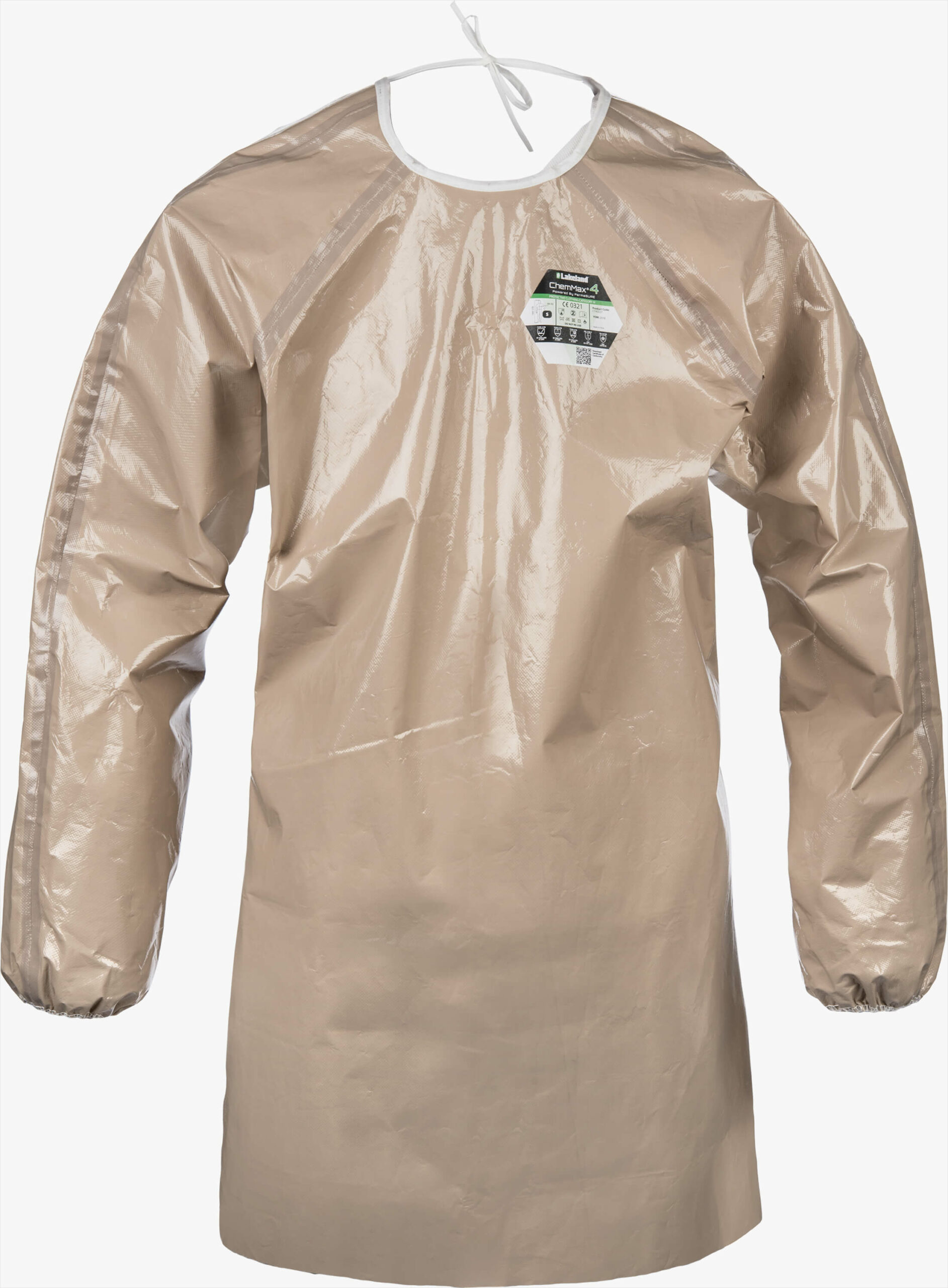ChemMax® 4 Plus Chemical Splash Gown with Ties and Elastic Cuffs
If you’re interested in availability, please speak with a Lakeland product specialist or your local distributor.
Chemical protective rear-entry chemical splash gown with sleeves and waist ties and supported by Permasure®. Stitched and taped, sealed seams. Partial Body EN Type 3[PB] liquid jet spray and Type 4[PB] liquid spray chemical protection. ChemMax® 4 Plus fabric is tough and durable, using multi-layer high chemical barrier polymer films. It provides permeation resistance against challenging chemicals such as Bromine (EN Class 2), Diethylamine (EN Class 6) and Tetrahydarfuran (Class 6), and with over 80 chemicals permeation resistance tested. CheMax® 4 Plus also works with Permasure®, Lakeland's easy-to-use smart-phone app that calculates safe-wear times for over 4000 chemicals, accounting for the effect of temperature on permeation rate and chemical toxicity. The fabric co-extrusion production process results in a low noise, flexible and smooth finish that is more fabric-like and has no bonding dimples where a chemical might cling as commonly seen in many chemical suit fabrics. Infectious Agent Barrier – passes all four EN 14126 bio-hazard tests at the highest classes. Tested for resistance against seven key chemical warfare agents so suitable for military, anti-terrorist and civil defense applications. Certified to EN 1149-5 for static dissipative clothing.
Chemical protective rear-entry chemical splash gown with sleeves and waist ties and supported by Permasure®. Stitched and taped, sealed seams. Partial Body EN Type 3[PB] liquid jet spray and Type 4[PB] liquid spray chemical protection. ChemMax® 4 Plus fabric is tough and durable, using multi-layer high chemical barrier polymer films. It provides permeation resistance against challenging chemicals such as Bromine (EN Class 2), Diethylamine (EN Class 6) and Tetrahydarfuran (Class 6), and with over 80 chemicals permeation resistance tested. CheMax® 4 Plus also works with Permasure®, Lakeland's easy-to-use smart-phone app that calculates safe-wear times for over 4000 chemicals, accounting for the effect of temperature on permeation rate and chemical toxicity. The fabric co-extrusion production process results in a low noise, flexible and smooth finish that is more fabric-like and has no bonding dimples where a chemical might cling as commonly seen in many chemical suit fabrics. Infectious Agent Barrier – passes all four EN 14126 bio-hazard tests at the highest classes. Tested for resistance against seven key chemical warfare agents so suitable for military, anti-terrorist and civil defense applications. Certified to EN 1149-5 for static dissipative clothing.
Chemical protective rear-entry chemical splash gown with sleeves and waist ties and supported by Permasure®. Stitched and taped, sealed seams. Partial Body EN Type 3[PB] liquid jet spray and Type 4[PB] liquid spray chemical protection. ChemMax® 4 Plus fabric is tough and durable, using multi-layer high chemical barrier polymer films. It provides permeation resistance against challenging chemicals such as Bromine (EN Class 2), Diethylamine (EN Class 6) and Tetrahydarfuran (Class 6), and with over 80 chemicals permeation resistance tested. CheMax® 4 Plus also works with Permasure®, Lakeland's easy-to-use smart-phone app that calculates safe-wear times for over 4000 chemicals, accounting for the effect of temperature on permeation rate and chemical toxicity. The fabric co-extrusion production process results in a low noise, flexible and smooth finish that is more fabric-like and has no bonding dimples where a chemical might cling as commonly seen in many chemical suit fabrics. Infectious Agent Barrier – passes all four EN 14126 bio-hazard tests at the highest classes. Tested for resistance against seven key chemical warfare agents so suitable for military, anti-terrorist and civil defense applications. Certified to EN 1149-5 for static dissipative clothing.
Additional information
